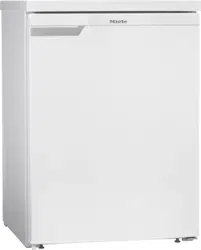Loading ...
Loading ...
Loading ...

Cleaning and care
34
- The humidity level in the room is low
and the ambient temperature in the
room is also low (cooler part of the
year).
Clean the interior with a clean
sponge, lukewarm water and a little
washing-up liquid.
After cleaning, wipe with clean water
and dry with a soft cloth.
The following parts cannot be cleaned
in a dishwasher:
- all drawers and the compartment lid
(depending on model)
- The adjustable shelves
These accessories should all be hand
washed.
Risk of damage as a result of ex-
cessively high dishwasher temperat-
ures.
Parts of the refrigeration appliance
may become unusable, e.g. deform,
if they are washed in the dishwasher
at more than 55°C.
For dishwasher-safe parts, only use
dishwasher programmes with a max-
imum temperature of 55°C.
Contact with natural dyes from car-
rots, tomatoes and ketchup, etc., may
discolour the plastic parts in the dish-
washer. This discolouration does not
affect the stability of the parts.
The following parts can be cleaned in
the dishwasher:
- the butter dish, egg tray, ice cube
tray
(depending on model)
- the shelves and bottle shelf in the
door
the butter and cheese compartment
Clean the condensate channel and
drain hole frequently so that con-
densate can drain away unhindered.
Use a straw or similar to clear the
drain if necessary.
Leave the door open to air the appli-
ance for a short while and to prevent
odours building up.
Cleaning the front of the appli-
ance and the side panels
If soiling is left on for any length of
time, it may become impossible to
remove. Surfaces may suffer discol-
ouration or damage.
Therefore, it is best to remove soiling
from the appliance front and side
panels immediately.
All surfaces are susceptible to
scratching. Contact with unsuitable
cleaning agents can alter or discol-
our the surfaces.
See the information on “Cleaning
agents” at the beginning of this sec-
tion.
Clean the surfaces with a clean
sponge and a solution of warm water
and washing-up liquid. A clean, damp
microfibre cloth without cleaning
agent can also be used.
After cleaning, wipe with clean water
and dry with a soft cloth.
Loading ...
Loading ...
Loading ...
